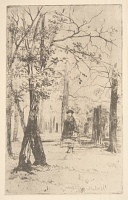Trees in a Park | ||
| Number: | 31 | |
| Date: | 1858/1859 | |
| Medium: | etching | |
| Size: | 200 x 124 mm | |
| Signed: | 'J. A. Whistler' and 'F. S. Haden' in reverse at lower right | |
| Inscribed: | no | |
| Set/Publication: | no | |
| No. of States: | 1 | |
| Known impressions: | 0 | |
| Catalogues: | K.2; M.App. 3; T.- | |
| Impressions taken from this plate (0) | ||
KEYWORD
girl, landscape, park, tree.
TITLE
Whistler's own title is not recorded. Suggested titles include:
'The Wood' (1909, Howard Mansfield (1849-1938)). 4
'Trees in the Park' (1910, Edward Guthrie Kennedy (1849-1932)). 5
'Girl in a wood' (2010, Whistler Etching Project).
'Girl in a wood' is a descriptive title, used because although the girl has not been identified she is central to the composition.
'The Wood' (1909, Howard Mansfield (1849-1938)). 4
'Trees in the Park' (1910, Edward Guthrie Kennedy (1849-1932)). 5
'Girl in a wood' (2010, Whistler Etching Project).
'Girl in a wood' is a descriptive title, used because although the girl has not been identified she is central to the composition.
4: Mansfield 1909 (cat. no. App. 3).
5: Kennedy 1910 (cat. no. 2).
DESCRIPTION
A girl is standing on a broad path through an open wood in spring or autumn. She is facing front, wearing a hat with a narrow brim, a wide-sleeved long jacket and full ankle-length skirt. At lower left are the trunks of two tall holly trees, crossing each other. Other trees, many of them bare of leaves, are lightly etched in the distance and to the right.
The etching was signed by both Whistler and Francis Seymour Haden, Sr (1818-1910); their names appear in reverse and are quite hard to read. No other etching by Whistler is signed like this.
SITTER
It is possible that Girl in a wood shows Annie Harriet Haden (1848-1937). The combination of figure and trees invites comparison with a portrait of her brother, Seymour [30].
Annie appears in several etchings between 1858 (Annie [7]) and 1860 (Annie Haden [67]). In Annie she is wearing short skirts, in Annie Haden, an ankle-length, wide, crinoline-supported skirt. If the girl in Girl in a Wood is indeed Annie Haden, her costume and apparent age helps to confirm a date of 1858 or 1859.
SITE
This was probably drawn in a London park. Mansfield suggested that it was 'Probably done in Greenwich Park at the same time as Whistler's "Greenwich Park" and "Greenwich Pensioner" and Haden's "Sub-Tegmine."' 6 However, both Haden's etching and Whistler's Greenwich Park [41] appear to show the park in summer.
Greenwich Park, the oldest enclosed Royal Park, now covers some 183 acres. It is on a hill over the river Thames, with splendid views over the city, and incorporates the old Royal Observatory and Queen's House. Avenues with mature trees (The Avenue, Great Cross Avenue, and Blackheath Avenue) and many smaller walks cross the park, and in the north-eastern corner is 'The Wilderness' (a deer park).
Greenwich Park, the oldest enclosed Royal Park, now covers some 183 acres. It is on a hill over the river Thames, with splendid views over the city, and incorporates the old Royal Observatory and Queen's House. Avenues with mature trees (The Avenue, Great Cross Avenue, and Blackheath Avenue) and many smaller walks cross the park, and in the north-eastern corner is 'The Wilderness' (a deer park).
6: Mansfield, op. cit.; F. S. Haden, Sub-Tegmine, etching and drypoint, 1859; the title is from Virgil's Eclogue 1 ('Tityre, tu patulae recubans sub tegmine fagi').
DISCUSSION
Kennedy suggested that it was only the girl that was drawn by Whistler:
'Though there may be but slight evidence that Whistler did any work on this plate, except upon the figure, the fact that he put his name on it must be sufficient authority for including it amongst his etchings'. 7
7: Kennedy 1910 (cat. no. 2).
The style and technique used by Whistler and Haden were inevitably very similar during the time they were learning to print etchings under the tutelage of Auguste Delâtre (1822-1907). However, Whistler was far more experienced at drawing both the figure and landscape; he had studied drawing in classes at the Academy of Arts and Science in St Petersburg, and topographical draughtsmanship under Robert Walter Weir (1803-1889) in the U. S. Military Academy at West Point, as well as drawing from models in the École Imperiale et Spéciale de Dessin in Paris.
